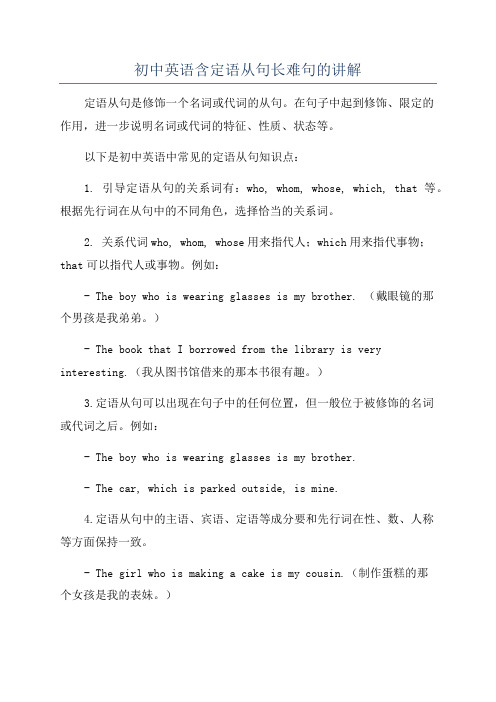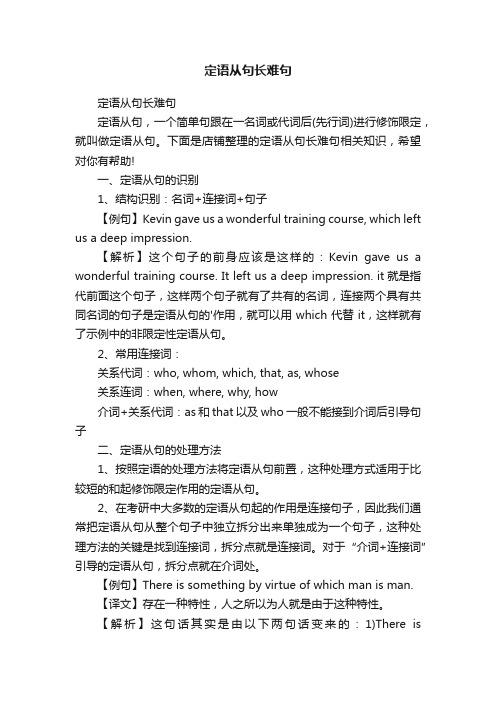第六章 定语从句及长难句的翻译
初中英语含定语从句长难句的讲解

初中英语含定语从句长难句的讲解定语从句是修饰一个名词或代词的从句。
在句子中起到修饰、限定的作用,进一步说明名词或代词的特征、性质、状态等。
以下是初中英语中常见的定语从句知识点:1. 引导定语从句的关系词有:who, whom, whose, which, that等。
根据先行词在从句中的不同角色,选择恰当的关系词。
2. 关系代词who, whom, whose用来指代人;which用来指代事物;that可以指代人或事物。
例如:- The boy who is wearing glasses is my brother. (戴眼镜的那个男孩是我弟弟。
)- The book that I borrowed from the library is very interesting.(我从图书馆借来的那本书很有趣。
)3.定语从句可以出现在句子中的任何位置,但一般位于被修饰的名词或代词之后。
例如:- The boy who is wearing glasses is my brother.- The car, which is parked outside, is mine.4.定语从句中的主语、宾语、定语等成分要和先行词在性、数、人称等方面保持一致。
- The girl who is making a cake is my cousin.(制作蛋糕的那个女孩是我的表妹。
)- The books that I borrowed from the library are due next week.(我从图书馆借来的那些书下周到期。
)5.当定语从句中的先行词是表示时间、地点或原因的词语时,关系代词可以省略。
- This is the place (that/which) I was born.(这就是我出生的地方。
)- Do you know the reason (why) he left early?(你知道他早退的原因吗?)6. 当定语从句中缺少主语时,可以使用关系副词where, when, why 引导。
(完整版)定语从句长难句分析

定语从句长难句分析1.These discoveries have led to the field known as neuroeconomics, which studies the brain’s secrets to success in an economic environment that demands innovation and being able to do things differently from competitors。
译文:这些发现带来了神经经济学领域的出现,神经经济学研究的是经济环境下大脑成功的秘诀,这个经济需要创新,需要和竞争者做不同的事情。
解析:which引导的是一个非限制性定语从句,因为neuroeconomics是一个专有名词,在语法中,是需要非限制性定语从句修饰的。
同时,这也是一个嵌套定语从句,也就是从句套从句,在which引导的非限制性从句中还包含着一个that引导的从句修饰economic environment.2.Those who are professionally engaged in the art of interpreting history are thus ina difficult position, as they must steer a narrow course between the demands of ‘evidence' and ‘attractiveness’,especially given the increasing need in the heritage industry and income- generating activities.译文:那些专门从事诠释历史的人面临着一个困境,他们需要在证据的要求和参观者对于吸引力的要求之间做出权衡,特别是考虑到历史遗产产业对于创收活动不断增长的要求。
初中英语含定语从句长难句的讲解

初中英语含定语从句长难句的讲解初中英语中定语从句是一个重要的语法知识点,掌握了定语从句的用法可以帮助学生更准确地描述人和物,并在写作中丰富句子结构。
以下是初中英语必须掌握的定语从句知识点以及一些含定语从句的长难句的讲解:1.定语从句用来修饰前面的名词,在句子中充当定语。
例如:The book that I just bought is very interesting.(我刚刚买的那本书非常有趣。
)定语从句“that I just bought”修饰名词“book”。
2.引导定语从句的词有:- 关系代词:that, which, who, whom, whose。
- 关系副词:when, where, why。
3.关系代词的选择:- 当先行词是人时,用who/that作主语,用whom/that作宾语,用whose表示所有关系。
- 当先行词是物时,用which/that作主语、宾语或表语。
- 当先行词有先行指示词this/that时,用which/that作关系代词。
4.关系副词的使用:- when引导的定语从句表示时间,相当于介词+时间状语从句的定语从句。
- where引导的定语从句表示地点,相当于介词+地点状语从句的定语从句。
- why引导的定语从句表示原因,相当于介词+原因状语从句的定语从句。
下面是一些含定语从句的长难句的讲解:1. The girl who is talking to Tom is my sister.(和汤姆说话的那个女孩是我姐姐。
)定语从句“who is talking to Tom”修饰名词“girl”。
2. The book that I borrowed from the library is very interesting.(我从图书馆借的那本书非常有趣。
)定语从句“that I borrowed from the library”修饰名词“book”。
3. The house where they used to live has been demolished.(他们过去住的那栋房子已经被拆除了。
第六章 定语从句的翻译及长难句的翻译

医学英语翻译课程讲稿第六章定语从句的翻译及长难句的翻译课时:2教学目的要求:让学生掌握定语从句及长难句的翻译方法教学重点、难点:定语从句的翻译;长难句的句子结构分析教学安排:第一课时讲解定语从句的翻译方法;第二课时讲解长难句的翻译,然后讨论分析和总结,最后布置翻译句子的练习。
教学内容:定语从句的翻译在翻译定语从句之前,必须先搞清从句与主句的限制性或非限制性关系,掌握关系代词或关系副词与主句先行词的关系,然后考虑汉语的表达习惯,进行恰当的翻译。
总的来说,定语从句的译法主要有以下几种:1. 合译法所谓合译,就是将定语从句译为主句中先行词的修饰语,即译成“……的”。
这种译法适用于定语从句较短、从句对先行词的限制性较强的情况,另外,只要译成汉语后的定语修饰语不太长、意思清楚、句子又通顺都可或应这样译。
1. 合译法1. Chronic tonsillitis is a disease on which there has been much controversy.慢性扁桃体炎是一种有许多争议的疾病。
1. 合译法2.Diseases in which structure changes are demonstrable are known as organic diseases.呈现结构变化的疾病称为器质性疾病。
1. 合译法3. Anything that happens anywhere in your body is likely to influence your nervous system in one way or another, and anything that influences your nervous system affects the rest of your body.体内任何部位发生的情况都可能对神经系统产生某种程度的影响,而任何影响神经系统的情况都会累及身体的其余部位。
第六章 定语从句及长难句的翻译

2. 分译法
• 分译法即将定语从句译成与主句并列的一个分句,采 取分译法时,从句中的关系词翻译可以重复先行词, 也可译成“他(们)”、“它(们)”等,有时也可 译成“但是”、“而”等,表示转折关系。
2. 分译法
1.The local reaction frequently invites a vasodilatory reflex, which increases the engorgement of the spongy tissues of the nose. • 局部反应往往引起血 管扩张性反射,这种 反射增加鼻海绵组织 的充血。
3. 顺序译法
• 所谓顺序译法,就是将定
语从句的关系词省略不译, 将主句与从句顺序而下译 为一个整句
3. 顺序译法
1.The
heart is muscular organ which is divided into a right and left half by a muscular wall.
4. 译成各种状语从句
6. Every patient with valvular or congenital heart disease who develops an obscure fever which persists for more than a few days should be suspected.(表 示条件) • 任何辫膜性或先天性心脏病患者,如出现原因不 明的发热,并持续多天,即应加以怀疑。 7. Much the most important early symptom of tetanus is trismus, a painless spasm of the masseter muscles which causes difficulty in opening the mouth and in masticating.(表示伴随的情况) • 破伤风最重要的早期症状为牙关紧闭,即咀嚼肌 无痛性痉挛,引起张口和咀嚼困难。
定语从句长难句

定语从句长难句定语从句长难句定语从句,一个简单句跟在一名词或代词后(先行词)进行修饰限定,就叫做定语从句。
下面是店铺整理的定语从句长难句相关知识,希望对你有帮助!一、定语从句的识别1、结构识别:名词+连接词+句子【例句】Kevin gave us a wonderful training course, which left us a deep impression.【解析】这个句子的前身应该是这样的:Kevin gave us a wonderful training course. It left us a deep impression. it就是指代前面这个句子,这样两个句子就有了共有的名词,连接两个具有共同名词的句子是定语从句的'作用,就可以用which代替it,这样就有了示例中的非限定性定语从句。
2、常用连接词:关系代词:who, whom, which, that, as, whose关系连词:when, where, why, how介词+关系代词:as和that以及who一般不能接到介词后引导句子二、定语从句的处理方法1、按照定语的处理方法将定语从句前置,这种处理方式适用于比较短的和起修饰限定作用的定语从句。
2、在考研中大多数的定语从句起的作用是连接句子,因此我们通常把定语从句从整个句子中独立拆分出来单独成为一个句子,这种处理方法的关键是找到连接词,拆分点就是连接词。
对于“介词+连接词”引导的定语从句,拆分点就在介词处。
【例句】There is something by virtue of which man is man.【译文】存在一种特性,人之所以为人就是由于这种特性。
【解析】这句话其实是由以下两句话变来的:1)There issomething. 2)Man is man by virtue of this thing.这两句话中有共有的名词something和this thing,用which替换掉this thing再把of which提前,得到:There is something of which man is man by virtue.三、例句分析【例句】Such large, impersonal manipulation of capital and industry greatly increased the numbers and importance of shareholders as a class, an element in national life representing irresponsible wealth detached from the land and the duties of the landowners; and almost equally detached from the responsible management of business.【译文】对资本和企业的这种大规模的非个人操纵大大增加了股东作为一个阶级的数量和重要性。
初中英语含定语从句长难句的讲解
初中英语含定语从句长难句的讲解定语从句是修饰一个名词或代词的句子,常用来给人或事物添加更多的描述信息。
下面是初中英语中必须掌握的定语从句知识点和一些例句:1. 定语从句引导词:关系代词who, whom, whose, which, that和关系副词when, where, why。
例句:- The boy who is standing over there is my friend.- This is the book which/that I bought yesterday.- Do you know the reason why he is late?2.关系代词的不同用法:-主语:关系代词在定语从句中作为主语时,后面的动词要用单数形式。
例句:The teacher who teaches us English is very nice.-宾语:关系代词在定语从句中作为宾语时,后面的动词应该与先行词的主语保持一致。
例句:I have a brother who/whom I love very much.- 所有格:关系代词whose表示所有关系,用来修饰人或物。
例句:The girl whose bag was stolen reported it to the police.3.关系副词的使用:- when:表示时间,在定语从句中作时间状语。
例句:I still remember the day when I first met her.- where:表示地点,在定语从句中作地点状语。
例句:This is the school where I study.- why:表示原因,在定语从句中作原因状语。
4.定语从句的省略:-当定语从句中的主语和主句的主语相同或是物主代词时,可以省略关系代词或关系副词。
例句:The book (that/which) he borrowed from me is very interesting.-当定语从句中的宾语和主句的宾语相同时,可以省略关系代词或关系副词。
定语从句的三种常见翻译法
定语从句的三种常见翻译法 考研英语中,从句是最常见的语法形式,也是构成长难句的基本要素。
正是因为从句的存在,才使得句⼦的表达层次化、多样化、复杂化。
因⽽在翻译过程中,从句也往往成为令⼈头痛的存在。
今天以定语从句为例,我们来看看⼏种常见的翻译⽅法,希望能对即将⾯对2016考研的同学有所帮助。
⼀、前置译法 如果⼀个定语从句在句中的作⽤是修饰和限定名词,那么通常就采取译为前置定语的⽅法。
但注意译成前置定语后既不能影响原⽂所表达的意思,还要使整个句⼦的表达⾔简意赅、连贯通顺、语⽓较强。
例句:Water, which is a clear liquid, has many uses. 译⽂:⽔是⼀种清澈的液体,有许多⽤途。
在前置译法的过程中如果定语从句中的谓语不含有具体意义,可省译从句中的谓语。
这种译法很简便,也很有效。
有时候,出于汉语⾏⽂的需要和逻辑关系⽅⾯的考虑,可将定语从句提在主语之前翻译,⽤来说明情况,但不作为被修饰名词的定语。
例句:There are also great advantages that come from the variety ofculture brought by settlers from other lands. 译⽂:移民从个地⽅带来了多种⽂化,产⽣了极⼤的好处。
⼆、后置译法 我们都知道,英语中很多定语从句都是为了连接两个具有共同名词的句⼦⽽存在的,因此在翻译时最好分为两个分句。
⽽对于起限定作⽤的定语从句,如果结构较为复杂,句⼦太长,⽆法译成前置的定语,最后就译成⼀个后置的并列分句,这样更合乎汉语的习惯。
例句:Our war against terror is a contest of will in which perseveranceis power. 译⽂:我们的反恐战争是⼀场意志⼒的较量。
在这场较量中,不屈不挠的精神就是⼒量。
结构较复杂的定语从句常译成后置的并列分句,在多数情况下要重译先⾏词,或即便句⼦不长,出于某种原因需要强调先⾏词,也要重译先⾏词。
定语从句长难句分析
定语从句长难句分析1.These discoveries have led to the field known as neuroeconomics, which studies the brain’s secrets to success in an economic environment that demands innovation and being able to do things differently from competitors.译文:这些发现带来了神经经济学领域的出现,神经经济学研究的是经济环境下大脑成功的秘诀,这个经济需要创新,需要和竞争者做不同的事情。
解析:which引导的是一个非限制性定语从句,因为neuroeconomics是一个专有名词,在语法中,是需要非限制性定语从句修饰的。
同时,这也是一个嵌套定语从句,也就是从句套从句,在which引导的非限制性从句中还包含着一个that 引导的从句修饰economic environment.2.Those who are professionally engaged in the art of interpreting history are thus in a difficult position, as they must steer a narrow course between the demands of ‘evidence’ and ‘attractiveness’, especially given the increasing need in the heritage industry and income- generating activities.译文:那些专门从事诠释历史的人面临着一个困境,他们需要在证据的要求和参观者对于吸引力的要求之间做出权衡,特别是考虑到历史遗产产业对于创收活动不断增长的要求。
定语从句翻译
• 这是最为常见的一种英译汉的方式,翻译成中 文时,将定语部分放在被修饰名词的前面。
• 例1:He is not the one who will give up easily. 译文:他不是一个轻易服输的人。
• 例2:Our two countries are neighbors whose friendship is of long standing. 译文:我们两国是友谊长存的友好邻邦。
3.译成相对独立的小分句
• 有些定语从句在修饰关系上与先行词之间关系显得较 为疏远,这时,我们通常会将定语从句译成独立的句 子。
• 例1: One was a violent thunderstorm, the worst I had ever seen, which obscured my objective. 译文:有一次暴风骤雨,猛烈的程度实在是我平生所 鲜见的。这场暴风雨遮住了我的目标。
2.不翻译关系代词或关系副词
• 有些定语从句表面上是非限制性定语从句,但在意义上却已经和 主句融为了一体。在翻译时,应该将引导定语从句的关系词省略, 从而使句子的意思显得更为连贯。
• 例1: After dinner, the four key negotiators resumed their talks, which continued well into the night. 译文:晚饭后,四个主要谈判人物继续进行会谈,一直谈到深夜。
• 二、分译法:
• 分译法是指将主句和从句分开翻译的一种方法, 主要用于较长的非限制性定语从句里。采用这 种方法可避免句子的冗长和累赘。这种方法一 般采用主句在前,从句在后的翻译形式,将句 子翻译成两个相对独立的小分句。
- 1、下载文档前请自行甄别文档内容的完整性,平台不提供额外的编辑、内容补充、找答案等附加服务。
- 2、"仅部分预览"的文档,不可在线预览部分如存在完整性等问题,可反馈申请退款(可完整预览的文档不适用该条件!)。
- 3、如文档侵犯您的权益,请联系客服反馈,我们会尽快为您处理(人工客服工作时间:9:00-18:30)。
• Normal-pressure glaucoma is usually defined by the clinical features of optic disk cupping, visual field loss, open angles, intraocular pressure in the statistically normal range, and the absence of any causative ocular or systemic disease.
2. 分译法
• 分译法即将定语从句译成与主句并列的一个分句,采 取分译法时,从句中的关系词翻译可以重复先行词, 也可译成“他(们)”、“它(们)”等,有时也可 译成“但是”、“而”等,表示转折关系。
2. 分译法
1.The local reaction frequently invites a vasodilatory reflex, which increases the engorgement of the spongy tissues of the nose. • 局部反应往往引起血 管扩张性反射,这种 反射增加鼻海绵组织 的充血。
4. 译成各种状语从句
3. The disease, which may occur at any age, is most frequent in early adult life.(表示让步) • 此病虽可发生于任何年龄,但以年轻人最为常见。 4. The blood flow may be increased by more rapid and vigorous heart action, which accelerates the movement of heat to the skin. • 血流可因更快和更有力的心脏活动而增加,结果 使热量加速转移至皮肤。(表示结果) 5. The sick child who had been given the medicine soon fell asleep.(表示时间) • 病孩服药后很快就入睡了。
3. 顺序译法
• 所谓顺序译法,就是将定
语从句的关系词省略不译, 将主句与从句顺序而下译 为一个整句
3. 顺序译法
1.The
heart is muscular organ which is divided into a right and left half by a muscular wall.
4. 译成各种状语从句
2.Pancreatic juice is produced by the lobules and passes into the duodenum during digestion, which it aids. (表示目的) • 胰液由小叶产生,在消化时进入十二指肠,以帮助消化。
1. 合译法
3. Anything that happens anywhere in your body is likely to influence your nervous system in one way or another, and anything that influences your nervous system affects the rest of your body. • 体内任何部位发生的情况 都可能对神经系统产生某 种程度的影响,而任何影 响神经系统的情况都会累 及身体的其余部位。
4. 译成各种状语从句
6. Every patient with valvular or congenital heart disease who develops an obscure fever which persists for more than a few days should be suspected.(表 示条件) • 任何辫膜性或先天性心脏病患者,如出现原因不 明的发热,并持续多天,即应加以怀疑。 7. Much the most important early symptom of tetanus is trismus, a painless spasm of the masseter muscles which causes difficulty in opening the mouth and in masticating.(表示伴随的情况) • 破伤风最重要的早期症状为牙关紧闭,即咀嚼肌 无痛性痉挛,引起张口和咀嚼困难。
• Smoothing the expressions
• When a man looks at an object, the light passes through my lens, which brings it into correct focus on my retina, a kind of onionskin wall-paper which covers the rear two-thirds of my interior. • 人观看物体时,光线穿过我的晶状体,晶状体 再把光线送到视网膜上合适的焦点处。视网膜 类似于洋葱皮墙纸,覆盖了我内部三分之二的 区域。
• 心脏是肌性器官, 由肌壁分为左右两 半。
3. 顺序译法
2.There are two major factors that affect the pulse pressure. • 有两种重要因素 对脉压产生影响 。
3. 顺序译法
3.In secondary shock, which comes on later, it may be
第六章 定语从句的翻译及长难 句的翻译
定语从句的翻译
• 在翻译定语从句之前,必须先搞清从句与主句的 限制性或非限制性关系,掌握关系代词或关系副 词与主句先行词的关系,然后考虑汉语的表达习 惯,进行恰当的翻译。总的来说,定语从句的译 法主要有以下几种:
1. 合译法
• 所谓合译,就是将定语从 句译为主句中先行词的修 饰语,即译成“ …… 的”。 这种译法适用于定语从句 较短、从句对先行词的限 制性较强的情况,另外, 只要译成汉语后的定语修 饰语不太长、意思清楚、 句子又通顺都可或应这样 译。
that neurogenic factors play a part.
• 继发性休克发生较迟,可能有神经元素在起作用。
4. 译成各种状语从句
• 有时,定语从句在意义 上起着各种状语从句的 作用,表示主句的时间、
原因、目的、条件、结
果或伴随的情系表示出来。
Adverbial Clauses
5. 其他译法
3. Amicroscopic examination of the urine determines the presence of nephritis, which is the most common kidney disease. • 尿的显微镜检查可确 定是否患肾炎 —— 一 种最常见的肾病。 (译成破折号号形式)
长难句的翻译
• Characteristics of English long sentences
• 1. Lots of modifiers • 2. Lots of joint parts • 3. Complicated structure
Steps in translating an English long sentence
2. 分译法
2.Several different clinical classifications exist, which vary only in details.
• 有几种不同的临床分类法,但这些方法也 只是细节上有所差别。
2. 分译法
3.Gastroenteritis may produce vomiting, abdominal pain, and fever that are difficult to distinguish from those of acute appendicitis. • 胃肠炎可产生呕吐、腹 痛和发热,而这些症状 很难与急性阑尾炎相区 别。
5. 其他译法
• 虽然以上几种译法 如能在翻译实践中 正确和灵活运用, 一般能解决定语从 句的翻译问题,但 有时仍需要根据具 体情况采取一些特 殊的译法才能妥帖 地表达好原句的意 思。
5. 其他译法
1. The dosage should be decreased gradually to the minimal effective level which may be a as low as 100 mg daily. • 剂量应逐渐递减为最低有效水平,即日剂 量低至100毫克。(译为同位语) • 2. When in doubt, which is not infrequent, one will establish the diagnosis by laparotomy. • 如有怀疑(这种情况也是常见的),可通 过剖腹术诊断。(译成括号形式)
• 正常眼压青光眼通常是指,在临床特征上视神 经乳头杯状凹陷、视野缺失、开角、眼内压在 统计学上属正常范围,且没有成为诱因的眼内 或全身性疾病。
• As we untangle the genetics and fundamental causes of glaucomatous damage to the optic nerve, researchers and clinicians will understand the destructive factors affecting the optic disk and should be able to make more rational decisions about therapy, no matter what the level of intraocular pressure. • 在我们解释给视神经青光眼造成损害的遗传因 素及各种基本的原因时,研究人员和临床医生 则会了解影响视神经乳头的各种破坏性因素, 并且不管眼内压力如何,都可以做出更为合理 的治疗决定。
